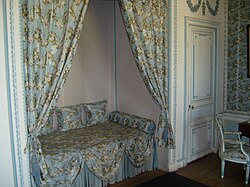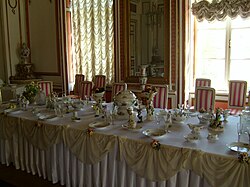415:
439:
403:
379:
92:
108:
391:
100:
427:
116:
140:
26:
124:
463:
367:
132:
475:
451:
205:
The Dutch House was constructed between 1749 and 1751 by architect Y.I. Kologrivov, who then enlarged the pond into a lake and laid out the park and canals. After the death of
Kologrivov in 1754, the construction of the palace was begun by the young architect Fiodor I. Argunov, who had designed the
242:
and Moscow. The exterior was made of wooden planks, which were plastered and painted in soft pastel colors. The palace looked out onto a court of honor, formed by the palace, the church and the large lake. The six-column portico at the front of the house was designed with a ramp so that carriages
213:
The twenty-six rooms of the palace were designed for entertaining and impressing guests on state occasions. Count
Sheremetev entertained in a grand style; his outdoor entertainments in the park attracted as many twenty-five thousand guests. Entertainments included his a famous theater and orchestra
162:
family. Built in the mid-18th century, it was originally situated several miles to the east of Moscow but now is part of the East
District of the city. It was one of the first great summer country estates of the Russian nobility, and one of the few near Moscow still preserved. Today the estate is
259:
of flowers, carefully trimmed hedges, and alleys which met at either right or diagonal angles, and were ornamented with statues, and lined with either rows of trees trimmed into spheres, large vases; orange trees; or myrtle trees trimmed into cones. Eight park alleys converge in a single point,
225:
After the 1917 Revolution, the estate was nationalized. In 1919 the palace was turned into a small museum of natural history. Ten years later it became the home of the state museum of porcelain, which had been founded in 1918–20 on
Podossensky Street in Moscow. It housed the nationalized
206:
grotto and the belvedere by the canal in the eastern part of the park. When Fiodor
Argunov became occupied with the construction of the Sheremetev house on the Fontanka in St. Petersburg, the task of designing the palace was given to the famous Moscow architect
221:
By the end of the 18th century, the estate went into a decline. It was badly damaged during the French invasion in 1812. In the 1830s, the serf theater was torn down. After the abolition of serfdom in 1861, parcels of land were divided up and rented out.
194:(1713–1788). Count Sheremetev was one of the richest men in Russia, close to the court and a patron of the arts. He built Kuskovo at approximately the same time that he built a city palace on the banks of the Fontanka River in
202:
from the center of Moscow, it was not designed to accommodate overnight guests, nor for agriculture or any other practical purpose, but purely as a place for entertainment, ceremony and festivities.
198:. When he decided to build a palace at Kuskovo, he ordered that it be larger and more beautiful than the estates of other nobles, and equal to any residence of the Czars. Since it was less than a
414:
769:
280:
A traditional brick Dutch house was constructed in the 1750s on a small pond near the Palace. the house has kitchen on the ground floor decorated from floor to ceiling with tiles from
243:
with as many as eight horses could come directly to the front door. When the carriage arrived, servants would rush out the front doors and hold the horses while the guests descended.
260:
where the circular
Hermitage pavilion (1764–77) now stands. Count Sheremetev spent most of his time in the Hermitage, coming to the Palace only for formal occasions and holidays.
672:
354:
Russian and Soviet porcelain of the 18th, 19th and 20th century. The collection of porcelain on revolutionary themes from the early Soviet period is particularly notable.
438:
749:
690:
759:
272:
was constructed between 1755 and 1761 by the architect F. Argunov, and was intended to represent the palace of the King of the Seas.
226:
collections of
Russian art collectors A. Morozov, L. Zoubalov, and Botkine. In 1932 it was renamed the State Museum of Ceramics.
739:
402:
308:
582:
744:
163:
the home of the
Russian State Museum of Ceramics, and the park is a favourite place of recreation for Muscovites.
426:
307:
The museum in the
Orangerie contains collections of fine porcelain assembled by Russian merchants and Empress
378:
143:
Service of Sèvres porcelain given by
Napoleon to Czar Alexander I in 1807, on display in the Dancing Hall.
764:
734:
729:
252:
191:
172:
462:
754:
312:
235:
45:
319:
German porcelain of the 18th and 19th centuries, particularly from the royal porcelain works at
366:
341:
390:
450:
8:
215:
682:
345:
337:
184:
91:
180:
107:
474:
655:
Boris Brodsky, "Les Trésors Artistiques de Moscou", Izibrazitelnoye Iskustvo, 1991.
199:
151:
83:
326:
176:
340:
in 1798 to commemorate his Egyptian campaign, and presented by Napoleon to Czar
296:
239:
195:
99:
583:"Architecture and Interesting Facts about Kuskovo Estate [In English]"
187:. There was already a wooden church on the site, a house and several ponds.
723:
705:
692:
295:
In 1919 the palace was nationalized, and it was declared the State Museum of
115:
586:
336:. One highlight of the collection is the Egyptian service, commissioned by
658:
A.L Batalov, E.I. Kirichenko, M.M. Posokhin, A.V. Kuzmin, E.G. Schoboleva,
139:
650:
Guide to the State Museum of Ceramics and the 18th Century Kuskovo Estate
561:
Guide to the State Museum of Ceramics and the 18th Century Kuskovo Estate
520:
Guide to the State Museum of Ceramics and the 18th Century Kuskovo Estate
25:
207:
159:
123:
497:
Kuskovo is also the name of the village that grew up round the estate.
256:
333:
332:
French porcelain from the 18th century from manufacture royale of
251:
The park of Kuskovo was created between 1750 and 1780 as a formal
320:
179:, who led the Russian Army in the victory over the Swedes at the
131:
269:
65:
55:
770:
Cultural heritage monuments of federal significance in Moscow
281:
572:
Boris Brodsky, "Les Trésors artistiques de Moscou", pg. 136.
660:
Pamyatniki Arkhitecturi Moskviy, Okrestnosti Staroy Moskviy
677:
292:
The orangerie (1761–1764) was designed by F. Argounov.
683:
http://samlib.ru/s/shurygin_a_i/kuskovo.shtml/Kuskovo
214:
with serf actors. The estate was visited by Empress
238:
style, then becoming popular for state buildings in
171:
In the 17th century, Kuskovo became the property of
623:
621:
218:in 1775; an obelisk in the park marks the event.
158:) was the summer country house and estate of the
721:
618:
175:(1652–1719), a Russian field marshal under Czar
127:Hermitage in English landscape garden of Kuskovo
302:
351:Danish porcelain of the 18th and 19th century.
135:Garden à la Française and grotto at Kuskovo
229:
138:
130:
122:
114:
106:
98:
90:
722:
246:
190:The palace was constructed by his son
111:Everyday bedchamber of Kuskovo Palace
678:Official site of the Kuskovo Museum
662:, Moscow, Iskusstvo-XXI Vek, 2207.
325:English porcelain from Chelsea and
234:The palace was designed in the new
13:
673:Kuskovo, Moscow's only French park
275:
14:
781:
750:Decorative arts museums in Russia
666:
760:Historic house museums in Russia
557:Pamyatniki Arkhitecturiy Moskviy
544:Pamyatniki Arkhitecturiy Moskviy
507:Pamyatniki Arkhitekturiy Moskviy
473:
461:
449:
437:
425:
413:
401:
389:
377:
365:
287:
24:
642:
630:
609:
532:Pamyatniki Akhitekturiy Moskviy
103:Tapestry Room of Kuskovo Palace
740:Neoclassical palaces in Russia
600:
575:
566:
549:
537:
525:
512:
500:
491:
432:Aerial view of Kuskovo in 2008
1:
485:
468:Sheremetev Palace in Kuskovo.
263:
119:Dining Room of Kuskovo Palace
95:Kuskovo Church and Bell Tower
315:. The major sections are:
303:The State Museum of Ceramics
7:
10:
786:
358:
192:Petr Borisovich Sheremetev
173:Boris Petrovich Sheremetev
166:
155:
79:
71:
61:
51:
41:
36:
32:
23:
18:
255:, with large ornamental
745:Russian Baroque gardens
456:View of Kuskovo in 1999
372:View of Kuskovo in 1839
144:
136:
128:
120:
112:
104:
96:
706:55.73528°N 37.80750°E
408:View of the Orangerie
253:Garden à la française
230:The Palace of Kuskovo
142:
134:
126:
118:
110:
102:
94:
636:Brodsky, pg. 148-167
559:and Elena Eritsyan,
299:twenty years later.
702: /
247:The Park of Kuskovo
42:Architectural style
37:General information
711:55.73528; 37.80750
338:Napoleon Bonaparte
313:Russian Revolution
185:Great Northern War
145:
137:
129:
121:
113:
105:
97:
765:Sheremetev family
735:Palaces in Moscow
730:Museums in Moscow
606:Brodsky, pg. 111.
346:Tilsit Conference
181:Battle of Poltava
89:
88:
777:
755:Ceramics museums
717:
716:
714:
713:
712:
707:
703:
700:
699:
698:
695:
648:Elena Eritsyan,
637:
634:
628:
627:Brodsky, pg. 137
625:
616:
613:
607:
604:
598:
597:
595:
594:
585:. Archived from
579:
573:
570:
564:
553:
547:
541:
535:
529:
523:
518:Elena Eritsyan,
516:
510:
504:
498:
495:
477:
465:
453:
441:
429:
417:
405:
393:
381:
369:
157:
84:Pyotr Sheremetev
28:
16:
15:
785:
784:
780:
779:
778:
776:
775:
774:
720:
719:
710:
708:
704:
701:
696:
693:
691:
689:
688:
669:
645:
640:
635:
631:
626:
619:
614:
610:
605:
601:
592:
590:
581:
580:
576:
571:
567:
554:
550:
542:
538:
530:
526:
517:
513:
505:
501:
496:
492:
488:
481:
480:View of Kuskovo
478:
469:
466:
457:
454:
445:
442:
433:
430:
421:
418:
409:
406:
397:
394:
385:
382:
373:
370:
361:
327:Josiah Wedgwood
309:Maria Fedorovna
305:
290:
278:
276:The Dutch House
266:
249:
232:
177:Peter the Great
169:
12:
11:
5:
783:
773:
772:
767:
762:
757:
752:
747:
742:
737:
732:
686:
685:
680:
675:
668:
667:External links
665:
664:
663:
656:
653:
644:
641:
639:
638:
629:
617:
608:
599:
574:
565:
548:
536:
524:
511:
499:
489:
487:
484:
483:
482:
479:
472:
470:
467:
460:
458:
455:
448:
446:
443:
436:
434:
431:
424:
422:
419:
412:
410:
407:
400:
398:
395:
388:
386:
383:
376:
374:
371:
364:
360:
357:
356:
355:
352:
349:
330:
323:
304:
301:
289:
286:
277:
274:
265:
262:
248:
245:
240:St. Petersburg
231:
228:
196:St. Petersburg
183:(1707) in the
168:
165:
87:
86:
81:
77:
76:
73:
69:
68:
63:
59:
58:
53:
49:
48:
43:
39:
38:
34:
33:
30:
29:
21:
20:
9:
6:
4:
3:
2:
782:
771:
768:
766:
763:
761:
758:
756:
753:
751:
748:
746:
743:
741:
738:
736:
733:
731:
728:
727:
725:
718:
715:
684:
681:
679:
676:
674:
671:
670:
661:
657:
654:
651:
647:
646:
633:
624:
622:
612:
603:
589:on 2022-10-20
588:
584:
578:
569:
562:
558:
552:
545:
540:
533:
528:
521:
515:
508:
503:
494:
490:
476:
471:
464:
459:
452:
447:
440:
435:
428:
423:
416:
411:
404:
399:
392:
387:
380:
375:
368:
363:
362:
353:
350:
347:
343:
339:
335:
331:
328:
324:
322:
318:
317:
316:
314:
310:
300:
298:
293:
288:The Orangerie
285:
283:
273:
271:
261:
258:
254:
244:
241:
237:
227:
223:
219:
217:
211:
209:
203:
201:
200:day's journey
197:
193:
188:
186:
182:
178:
174:
164:
161:
153:
149:
141:
133:
125:
117:
109:
101:
93:
85:
82:
78:
74:
70:
67:
64:
60:
57:
54:
50:
47:
44:
40:
35:
31:
27:
22:
17:
687:
659:
649:
643:Bibliography
632:
615:Brodsky, 142
611:
602:
591:. Retrieved
587:the original
577:
568:
560:
556:
551:
543:
539:
531:
527:
519:
514:
506:
502:
493:
384:General view
306:
294:
291:
279:
267:
250:
236:neoclassical
233:
224:
220:
216:Catherine II
212:
204:
189:
170:
147:
146:
75:18th century
52:Town or city
46:Neoclassical
709: /
342:Alexander I
311:before the
724:Categories
697:37°48′27″E
593:2018-04-02
486:References
264:The Grotto
208:Karl Blank
160:Sheremetev
694:55°44′7″N
420:Hermitage
257:parterres
72:Completed
546:, pg. 49
534:, pg. 49
509:, pg. 49
348:in 1807.
297:Ceramics
156:Куско́во
652:, 1996.
359:Gallery
344:at the
321:Meissen
167:History
152:Russian
148:Kuskovo
62:Country
19:Kuskovo
563:,1996.
522:,1996.
396:Grotto
334:Sèvres
270:grotto
80:Client
66:Russia
56:Moscow
282:Delft
555:See
444:Park
268:The
726::
620:^
284:.
210:.
154::
596:.
329:.
150:(
Text is available under the Creative Commons Attribution-ShareAlike License. Additional terms may apply.







